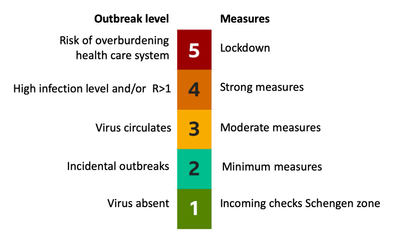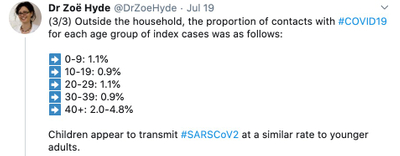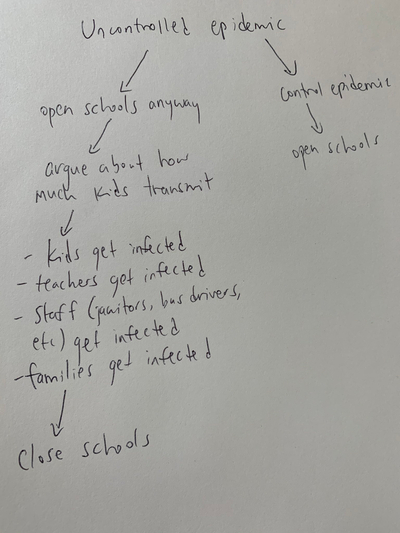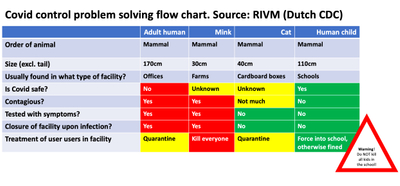Author: Michael Blok, August 1st 2020, based on research/input of, and discussion with, medical and education experts.
This file has several purposes and parts.
- A proposal for a Safe Schools Protocol
- An overview of the risks of Coronavirus for and by children
- What should we think of Government statements and guidelines about children and schools?
- Resources for concerned parents, teachers and school boards
Guide for Schools in Corona Times
Please download our Guide which you can then send on to the school your children attend. Many schools struggle with issues surrounding Covid. Help the school help your child!
Safe School Protocol proposal
The schools will reopen soon. Our children deserve the best. With compulsory education, you must protect the children in the building they are forced to stay in. And schools can be important locations for the virus to spread. With the current level of virus circulation, the current (relaxed) approach of the government is therefore insufficient. Our children simply need to enjoy safe education. But how?
Because nobody else seems to be doing it, Containment Now! has developed a proposal for an approach, in consultation with experts and based on scientific research and protocols in other countries. The protocol aims to be an input for an urgent discussion between schools, school boards, teacher unions, safety regions, Public Health Authorities and the cabinet.
Our Protocol is compatible with our 5-point plan for successfully tackling the outbreak that we presented back in May and which has been well received by a wide international audience. Government measures should be implemented regionally and depending on the local virus circulation and Alert Level (see Alert Levels in the graph).

Outbreak level 1 (no virus circulation) does not require measures to protect schools.
At Outbreak level 2 only minimal measures are required. Schools take "low cost" measures:
- Advice and monitoring of behavior regarding hand washing, shaking hands and keeping distance.
- Information for parents: children with complaints do not come to school, nor are children under quarantine obligations.
- Ventilating classrooms with open windows / doors and / or ventilation and (already legally required) CO2-meters in every room. Windows at least fully open from 800ppm CO2 concentration.
- Hygiene: regular (2x daily or after use) cleaning of toys, books, door handles and tables.
- Exercise outdoors where possible.
- Two weeks closure of a class with 1+ infected student, closure of a school with 2+ closed classes.
- No enforcement of compulsory education for families in a special situation (eg parents in risk group).
At Outbreak Level 3 (the situation in the Netherlands at the beginning of August 2020), additional stricter measures are needed to prevent schools from becoming dangerous to users and / or vectors for the virus. The government also facilitates distance education (centrally or schools which will then require additional resources).
- Students from 10 years old wear masks in the classroom and in the building
- High schools run at half classes to allow distancing
- Teachers are proactively tested weekly
- There are no restrictions on child testing from Public Health Authorities and the national hotline
- No sports indoors
- GGDs report all infections in schools (anonymously)
- No enforcement of compulsory education.
Schools should be closed from Outbreak Level 4. This would then be regional, only in the regions where there are too many infections. At Outbreak Level 5, all schools are closed nationally.
Unfortunately, we have to conclude that the measures we now apply would only be sufficient in Outbreak situation 1, while the Netherlands is in phase 3, partly in phase 4.
Is Coronavirus a danger to our children?
Generally, the danger is probably limited. Children can have health problems that can last a long time, but most children don't seem to notice anything, or only get sick for a few days or weeks. The much talked-about and dangerous Kawasaki syndrome is rare and is not (in itself) enough reason to go to great lengths to avoid infection. Roughly 1% of the infected children have to go to hospital for treatment, and a few percent of those children will die. Children seem to be less likely to become infected than adults, but perhaps more so in the real world in which they play together, according to a much-discussed study about a US-American summer camp.
The question whether "Long Covid" (roughly 10% of adults infected with symptoms seems to suffer for months or even a lifetime) is a concern in children has not yet been answered. There is certainly reason to believe that the damage is less than for adults, but the expected health damage in adults is a major concern, so to have no concern for children is too careless.
Conclusion: a lot is uncertain. Corona is less dangerous for children, but preventing contamination is certainly worthwhile.
Are children contagious to others?
Yes of course. Children are people, so they are contagious to some degree. There is not even conclusive evidence that children are less contagious than adults. Children seem to have about as much virus in their exhaled air as adults, as shown by multiple studies. Children breathe out less air because they are smaller, but of course they also behave less cautiously and more "physically social" than older people.

This study from Italy shows that children are more contagious than adults (and less likely to become infected). And in South Korea, it turned out that teenagers are more often infected than other groups and are responsible for about the same number of infections as other age groups.
Conclusion: Yes, children are contagious and probably not much less than adults.
Are open schools a risk to the local community?

Yes, when the virus circulates in the community. In schools, the virus spreads quickly from one or a few infected students to other students and their teachers. This is evident from research in Chile. A study in Israel provides the same picture: when circumstances led to masks being taken off in schools for three days, a new revival of the outbreak started a week later, which is as bad now as it was in the Spring. This picture is also repeated in France: the virus spreads quickly in schools, closing schools strongly inhibits the outbreak and opening schools revives the epidemic. This also applies to preschools, where children can quickly become infected and they also easily infect adults. The flow chart featured is from Harvard MD Abraar Karan.
Conclusion: Schools can only really open safely if the virus hardly circulates in a city or region.
In areas such as the Netherlands with a significant presence of the virus, the focus should be on suppressing the virus. Secondarily, measures such as masks, half classes, ventilation / open windows and distance learning can be used to limit the risks. Frequent testing, including proactively, of teachers and possibly students, prevents schools from fulfilling their potential role as super-spreading sites (see the proposed protocol above). The US Government has a good list of precautions, and so do we now.
But what should we make of the claims made by RIVM?
RIVM (the Dutch CDC) has been taking the position for months that children are hardly at risk of Covid-19. This is not the case (see above), but the risk for children is probably lower than for adults. Children are also said to be much less contagious, which is simply not true.

The decision of April 22 to open primary schools with halved classes, and shortly thereafter with a regular schedule, is therefore based either on a questionable interpretation of international research, or on a relaxed attitude towards the contamination of young people. In any case, the latter seems to be the case, because Outbreak Management Team member Ann Vossen explained in the TV show Jinek that it is not the intention to stop the virus, and that children in particular are seen as a relatively risk-free group in terms of infection. This is in line with the general policy: prevent chaos in hospitals and try to keep the elderly and vulnerable out of trouble (read: so leave younger healthy people in trouble, or at least make less effort to prevent that).
If your children's school says "we follow the RIVM guidelines" then a logical answer is "RIVM wants to spread the virus and infect children with priority, do you too?" or "RIVM makes many claims that are not correct. Do you think that children are not contagious? That they cannot be harmed by health? That the virus is only transmitted via spatter?
Conclusion: like so many other remarkable statements and decisions of the Dutch government, the relaxed attitude towards open schools cannot be separated from the policy of controlled dissemination.
What can parents do to protect their children and themselves?
The Dutch Cabinet plans to open the schools almost normally from 17 August. The conclusion seems inevitable that (in the current situation of tens of thousands of infected Dutch people) will lead to more transmission of the virus, perhaps much more transmission. It is going too far to say that open schools are really dangerous for children. But for children in at-risk groups, children with parents in risk groups and parents who just really don't want to be infected through their children, it seems important to be careful. This can be done in 4 ways:
- Join a petition for safe education
- Promote careful behavior of your children
- Keep the situation at the school as safe as possible
- Keep your kids out of school.
It is of course always useful to train your children to wash their hands and not touch others (too much). You can also explain to your child that symptoms in other children should be reported to teachers and parents.
On the fourth point, it seems home schooling will now be punished by the Government. You can take this risk and see what happens. Perhaps enforcement will be lax, perhaps the school will not report your kid's absence, and you can also decide to pay any fine levied.
You can also object to a possible fine and start a kind of test trial. You can count on judges giving you some wiggle room based on your obligation to have your own opinion on how to keep your child safe, given the current 400 measured infections per day (really 4,000+?). You can also consider emigrating (temporarily) and having your child educated in a country with much less virus, but that is of course a very big step. It is a step that several people with whom we are in contact, considering that the circulation of the virus and a relaxed attitude of the government towards the virus seem to be a feature of the Netherlands in the coming years.
On the second point, it is important to let your child go to a school that is as safe as possible. You can contribute to this (see also the complete protocol above) by helping come about:
- Good ventilation and open windows
- Careful and regular disinfection of door handles and WCs
- Half classes and keeping distance
- Masks (common in the rest of the world for (at least) teenagers)
- Temporary closure of a class or the entire school in case of proven contamination
Below is a sample letter for parents that they could send to the school management. The school will often answer: "we follow the RIVM guidelines". Above you can see why that is not a very strong argument.
You can also put pressure on your regional Health Authority to test teachers regularly, report infections in schools, and have a protocol to close classes or schools. Calling helps!
You can also join a petition for safe schools and distance learning.
Sample letter to the school board/school management/PTA
Dear management,
Our school will open again soon. You are undoubtedly aware of the rising infection levels in the Netherlands, which certainly do not make school education for children and teachers risk-free. Open schools can also be important sources of contamination for the community, while nobody wants to return to the difficult period in March / April.
All this puts school boards and teachers in a difficult situation. You are asked to comply with government guidelines, but you also have your own responsibility as an employer and carer for minors. All this is in the context of a government policy of controlled spread of the virus, which does not envisage maximum suppression of the virus. I extend my sympathy to the difficult choices you face as the virus continues to circulate, and to the risks of working in a school in this situation.
I also want to prevent my children from becoming infected and / or infecting me, and I feel responsible towards the teachers of my children. I therefore ask you to strongly consider the following measures:
- Fresh air: every room has a window open and an opposite window or door. Installation of (cheap and always legally required) CO2 meters that indicate when the ventilation is insufficient.
- Information will be provided to parents that children with complaints and / or under quarantine are not welcome at school.
- Closure in case of infection: if one or more students in a class are infected, the entire class and its teacher(s) are asked to stay at home for two weeks. If 3 or more classes are infected in this way, the whole school will close for 2 weeks.
- [If high school] Students and teachers wear masks in the school, except during sports activities.
In addition, we ask your effort on the following points:
- You make an effort to have your teaching staff proactively tested, preferably weekly.
- Sporting activities are organized outdoors where possible.
The above measures will by no means provide certainty that infections will not develop in the school, but will certainly reduce the chance of them. I hope you will treat this post as the constructive contribution to safe education that it is intended as, and that you will take the necessary steps to allow me and my children to go to school with peace of mind knowing that the school will do all that has done possible to prevent illness and worse.
Thank you for your time, success in the difficult period ahead, and best regards,
[Name of parent(s) / guardian(s).]
Image courtesy of atelier PRO, some rights reserved